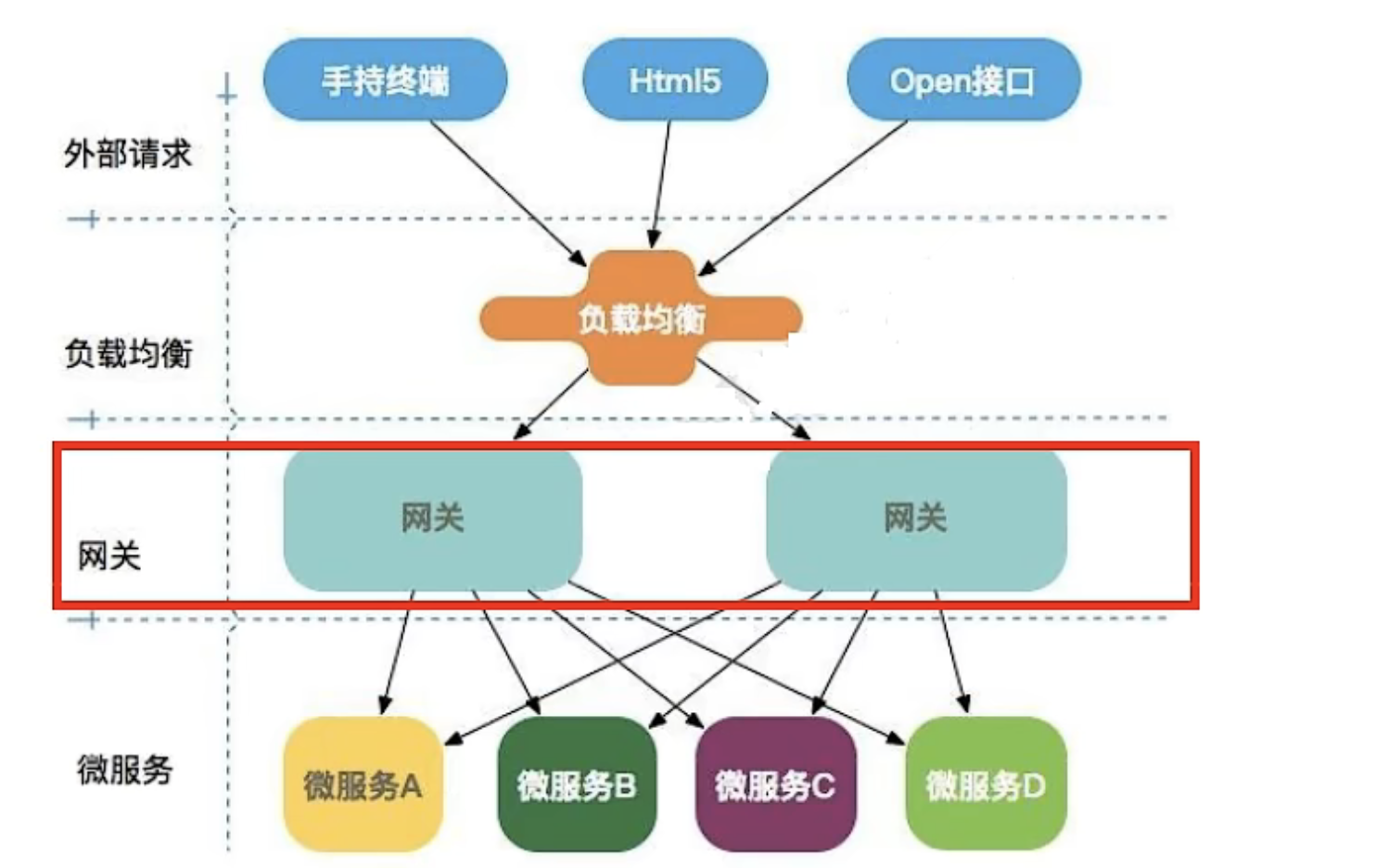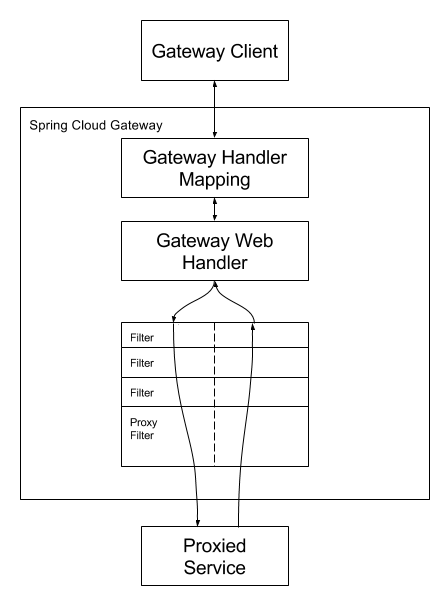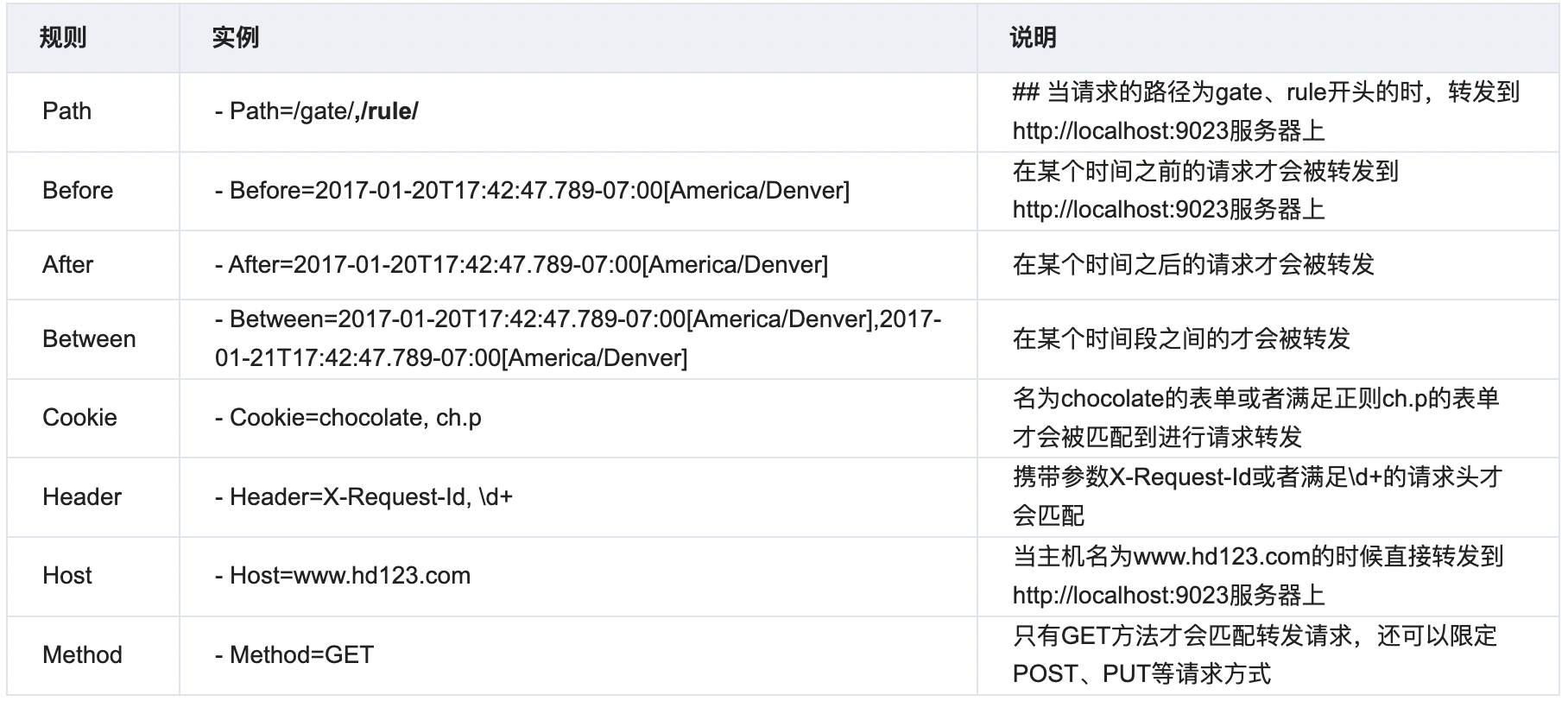Gateway基本介绍
Spring Cloud Gateway
官方网站:https://spring.io/projects/spring-cloud-gateway
Spring Cloud Gateway是基于Spring生态系统之上构建的API网关,包括:Spring 5.x,Spring Boot 2.x和Project Reactor。Spring Cloud Gateway旨在提供一种简单而有效的方法来路由到API,并为它们提供跨领域的关注点,例如:安全性,监视/指标,限流等。
什么是服务网关
API Gateway(APIGW / API 网关),顾名思义,是系统对外的唯一入口。API网关封装了系统内部架构,为每个客户端提供定制的API。 近几年来移动应用与企业间互联需求的兴起。从以前单一的Web应用,扩展到多种使用场景,且每种使用场景对后台服务的要求都不尽相同。 这不仅增加了后台服务的响应量,还增加了后台服务的复杂性。随着微服务架构概念的提出,API网关成为了微服务架构的一个标配组件。
为什么要使用网关
微服务的应用可能部署在不同机房,不同地区,不同域名下。此时客户端(浏览器/手机/软件工具)想要请求对应的服务,都需要知道机器的具体 IP 或者域名 URL,当微服务实例众多时,这是非常难以记忆的,对于客户端来说也太复杂难以维护。此时就有了网关,客户端相关的请求直接发送到网关,由网关根据请求标识解析判断出具体的微服务地址,再把请求转发到微服务实例。这其中的记忆功能就全部交由网关来操作了。
核心概念
路由(Route):路由是构建网关的基本模块,它由ID,目标URI,一系列的断言和过滤器组成,如断言为true则匹配该路由。
断言(Predicate):Java8 中的断言函数。开发人员可以匹配HTTP请求中的所有内容(例如请求头或请求参数),如果请求与断言相匹配则进行路由。
过滤器(Filter):一个标准的 Spring Web Filter。Spring Cloud Gateway 中的 Filter 分为两种类型,分别是 Gateway Filter 和 Global Filter。过滤器将会对请求和响应进行处理。

web请求,通过一些匹配条件,定位到真正的服务节点。并在这个转发过程的前后,进行一些精细化控制。
predicate就是我们的匹配条件;
而fliter,就可以理解为一个无所不能的拦截器。有了这两个元素,再加上目标uri,就可以实现一个具体的路由了
微服务架构中网关的位置

特性
- 基于Spring Framework 5,Project Reactor和Spring Boot 2.0进行构建;
- 动态路由:能够匹配任何请求属性;
- 可以对路由指定Predicate (断言)和Filter(过滤器);
- 集成Hystrix的断路器功能;
- 集成Spring Cloud 服务发现功能;
- 易于编写的Predicate (断言)和Filter (过滤器);
- 请求限流功能;
- 支持路径重写。
Gateway工作流程

客户端向Spring Cloud Gateway发出请求。然后在Gateway Handler Mapping 中找到与请求相匹配的路由,将其发送到GatewayWeb Handler。
Handler再通过指定的过滤器链来将请求发送到我们实际的服务执行业务逻辑,然后返回。
过滤器之间用虚线分开是因为过滤器可能会在发送代理请求之前(“pre”)或之后(“post")执行业务逻辑。
Filter在“pre”类型的过滤器可以做参数校验、权限校验、流量监控、日志输出、协议转换等,
在“post”类型的过滤器中可以做响应内容、响应头的修改,日志的输出,流量监控等有着非常重要的作用。
核心逻辑:路由转发 + 执行过滤器链。
Gateway9527搭建
Gateway环境准备
1、新建Module : cloud-gateway-gateway9527
2、POM文件
<?xml version="1.0" encoding="UTF-8"?>
<project xmlns="http://maven.apache.org/POM/4.0.0"
xmlns:xsi="http://www.w3.org/2001/XMLSchema-instance"
xsi:schemaLocation="http://maven.apache.org/POM/4.0.0 http://maven.apache.org/xsd/maven-4.0.0.xsd">
<parent>
<artifactId>cloud-kernel</artifactId>
<groupId>com.kernel.springcloud</groupId>
<version>1.0.0-SNAPSHOT</version>
</parent>
<modelVersion>4.0.0</modelVersion>
<artifactId>cloud-gateway-gateway9527</artifactId>
<properties>
<maven.compiler.source>8</maven.compiler.source>
<maven.compiler.target>8</maven.compiler.target>
</properties>
<dependencies>
<!--gateway-->
<dependency>
<groupId>org.springframework.cloud</groupId>
<artifactId>spring-cloud-starter-gateway</artifactId>
</dependency>
<!--eureka-client-->
<dependency>
<groupId>org.springframework.cloud</groupId>
<artifactId>spring-cloud-starter-netflix-eureka-client</artifactId>
</dependency>
<!-- 我们自己的公共模块 -->
<dependency>
<groupId>com.kernel.springcloud</groupId>
<artifactId>cloud-api-common</artifactId>
<version>${project.version}</version>
</dependency>
</dependencies>
</project>
3、resources/application.yml 配置文件
server:
port: 9527
spring:
application:
name: cloud-gateway
eureka:
instance:
hostname: cloud-gateway-service
client: #服务提供者provider注册进eureka服务列表内
service-url:
register-with-eureka: true
fetch-registry: true
defaultZone: http://localhost:7001/eureka
4、网关启动类
@SpringBootApplication
@EnableEurekaClient
public class GatewayApplication {
public static void main(String[] args) {
SpringApplication.run(GatewayApplication.class,args);
}
}
路由配置方式
在spring cloud gateway中配置uri有三种方式,包括 ws、http、lb
server:
port: 9527
spring:
application:
name: cloud-gateway
#############################新增网关配置###########################
cloud:
gateway:
discovery:
locator:
enabled: true # 开启从注册中心动态创建路由的功能,利用微服务名进行路由
routes:
- id: cloud-provider-service # 我们自定义的路由 ID,保持唯一,建议配合服务名
#uri: http://localhost:8001 # uri:目标服务地址 匹配后提供服务的路由地址
uri: lb://cloud-provider-service # 注册中心配置方式 表示从微服务注册中心(如Eureka)订阅服务,并且进行服务的路由。lb表示启用Gateway的负载均衡功能。
predicates:
- Path=/user/** # 断言,路径相匹配的进行路由
- id: cloud-provider-service2 # 我们自定义的路由 ID,保持唯一,建议配合服务名
#uri: http://localhost:8001 # uri:目标服务地址 匹配后提供服务的路由地址
uri: lb://cloud-provider-service # 注册中心配置方式 表示从微服务注册中心(如Eureka)订阅服务,并且进行服务的路由。lb表示启用Gateway的负载均衡功能。
predicates:
- Path=/hystrix/** # 断言,路径相匹配的进行路由
####################################################################
eureka:
instance:
hostname: cloud-gateway-service
client: #服务提供者provider注册进eureka服务列表内
service-url:
register-with-eureka: true
fetch-registry: true
defaultZone: http://localhost:7001/eureka
测试
http://localhost:8001/hystrix/success/1
http://localhost:9527/hystrix/success/1
两者访问成功,返回相同结果
路由规则(Predicate)
Spring Cloud Gateway创建Route对象时, 使用RoutePredicateFactory创建Predicate对象,Predicate对象可以赋值给Route。
- Spring Cloud Gateway包含许多内置的Route Predicate Factories。
- 所有这些断言都匹配 HTTP 请求的不同属性。
- 多个Route Predicate Factories可以通过逻辑与(and)结合起来一起使用。
路由断言工厂RoutePredicateFactory包含的主要实现类如图所示,包括Datetime、请求的远端地址、路由权重、请求头、Host 地址、请求方法、请求路径和请求参数等类型的路由断言。
转发规则(predicates),假设 转发uri都设定为http://localhost:9023

通过请求方式匹配
可以通过是 POST、GET、PUT、DELETE 等不同的请求方式来进行路由。
server:
port: 9527
spring:
cloud:
gateway:
routes:
- id: query_route
uri: https://example.org
predicates:
- Method=GET,POST
Datetime
匹配日期时间之后发生的请求
server:
port: 9527
spring:
cloud:
gateway:
routes:
- id: query_route
uri: https://example.org
predicates:
- After=2021-02-23T14:20:00.000+08:00[Asia/Shanghai]
获取时间
import java.time.ZonedDateTime;
public class T2{
public static void main(String[] args){
ZonedDateTime zbj = ZonedDateTime.now(); // 默认时区
System.out.println(zbj);
//2021-02-22T15:51:37.485+08:00[Asia/Shanghai]
}
}
Header
接收 2 个参数,一个 header 中属性名称和一个正则表达式,这个属性值和正则表达式匹配则执行。
server:
port: 9527
spring:
cloud:
gateway:
routes:
- id: query_route
uri: https://example.org
predicates:
- Header=X-Request-Id, \d+
curl http://localhost:8080 -H “X-Request-Id:88”
则返回页面代码证明匹配成功。将参数-H "X-Request-Id:88"改为-H "X-Request-Id:spring"再次执行时返回404证明没有匹配。
通过请求参数匹配
Query Route Predicate 支持传入两个参数,一个是属性名一个为属性值,属性值可以是正则表达式。
server:
port: 9527
spring:
cloud:
gateway:
routes:
- id: query_route
uri: https://example.org
predicates:
- Query=smile
这样配置,只要请求中包含 smile 属性的参数即可匹配路由。
还可以将 Query 的值以键值对的方式进行配置,这样在请求过来时会对属性值和正则进行匹配,匹配上才会走路由。
server:
port: 9527
spring:
cloud:
gateway:
routes:
- id: query_route
uri: https://example.org
predicates:
-Query=keep, pu.
这样只要当请求中包含 keep 属性并且参数值是以 pu 开头的长度为三位的字符串才会进行匹配和路由。
组合使用
server:
port: 9527
spring:
application:
name: api-gateway
cloud:
gateway:
routes:
- id: gateway-service
uri: https://www.baidu.com
order: 0
predicates:
- Host=**.foo.org
- Path=/headers
- Method=GET
- Header=X-Request-Id, \d+
- Query=foo, ba.
- Query=baz
- Cookie=chocolate, ch.p
各种 Predicates 同时存在于同一个路由时,请求必须同时满足所有的条件才被这个路由匹配。
一个请求满足多个路由的断言条件时,请求只会被首个成功匹配的路由转发
全局过滤器
全局过滤器作用于所有的路由,不需要单独配置,我们可以用它来实现很多统一化处理的业务需求,比如权限认证,IP访问限制等等。
单独定义只需要实现GlobalFilter, Ordered这两个接口就可以了。
/**
* 全局过滤器
*/
@Component
public class AuthFilter implements GlobalFilter, Ordered {
@Override
public Mono<Void> filter(ServerWebExchange exchange, GatewayFilterChain chain) {
String token = exchange.getRequest().getQueryParams().getFirst("token");
if (null == token) {
ServerHttpResponse response = exchange.getResponse();
response.getHeaders().add("Content-Type", "application/json; charset=utf-8");
String message = "{\"message\":\"请求token信息不能为空\"}";
DataBuffer buffer = response.bufferFactory().wrap(message.getBytes());
return response.writeWith(Mono.just(buffer));
}
return chain.filter(exchange);
}
// 加载顺序 优先级。数字越小 优先级越高
@Override
public int getOrder() {
return 0;
}
}
